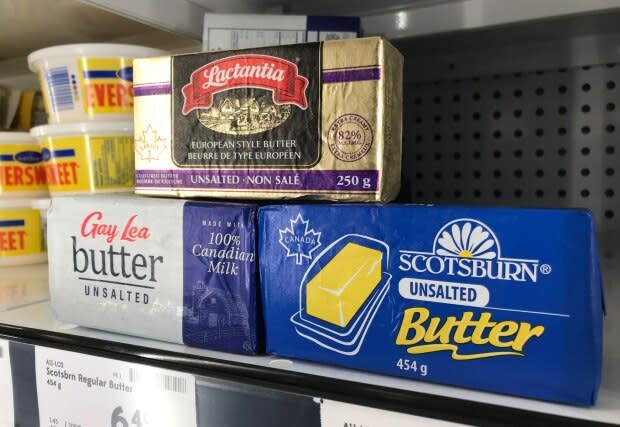Newfoundland-made butter could soon be a thing, if these farmers succeed
A group of Newfoundland dairy farmers say they're missing one final piece of the puzzle to go forward with their plans to build a processing plant on the island to turn milk into butter and other products, but are hoping it falls into place soon.
The Real Dairy Company of Newfoundland — a co-op-style organization of 13 of the province's milk producers along with an Irish dairy company — is looking to build its plant in Deer Lake's industrial park, which members say could handle all the excess milk produced on the island.
"Our vision, first of all, is to provide stability for our dairy industry, by having a home to process all on-island production," said Brent Chaffey, who runs New World Dairy in St. David's and has been among those working for years on the project.
"We need to do more. We can do more."
Milk has long been a bright spot in the province's agriculture scene, as one of only a handful of products that are made in enough quantities within Newfoundland and Labrador to satisfy the province's needs. There might even be too much of it, as — barring a few tiny companies — none of the leftover milk is turned other dairy products, and about 16.5 million litres of excess milk is shipped each year to the mainland to be processed.
That's always been a risky endeavour, with the short shelf life of unprocessed fluid milk meaning any slight travel delay creates waste, as Chaffey knows all too well: in 2015 he lost $100,000 worth of milk after thick ice prevented Marine Atlantic from making crossings.
"We always knew that we were vulnerable," he said.
"Anything that would affect that service, that ferry service, also affects our ability to move milk."

Butter's business case
One major hurdle behind the scenes has been the business plan for the project. Secondary processing has come and gone from Newfoundland before, most recently with the St. John's Scotsburn ice cream plant closing in 2016, citing cost pressures. Central Dairies at one time also had its hand in secondary processing, and a yogurt facility in Stephenville, which Chaffey part-owned, burned down in 2006, never to be rebuilt.
Part of what's different about the new processing plant, according to Chaffey, is its all-Newfoundland and Labrador ownership system, plus the expertise of Ireland's Glenstall Foods, who were sourced by a consultant through an intensive search.
Sales of fluid milk have been slipping for years, even prior to the pandemic causing demand to plummet, creating a glut that mainland processors managed by turning into other products, said Chaffey. He also said evolving consumer habits show people are more frequently choosing dairy products other than milk, and he and his team want to capitalize on that.
The business plan starts with butter and skim milk powder, a product found in baking mixes and other industrial uses, but it doesn't end there.
"We want to find ways to get creative, and bring some value-added products in there. Products that would be of more commercial interest, in yogurts and cream cheeses and other products," he said.
Cash crunch
The processing plant doesn't come cheap. It has a $25-million price tag, of which Chaffey said $17 million has been secured so far, including last week's promise from the provincial government to chip in $5 million.
"Their financial support is reflective of the encouragement that they've placed at our feet throughout this process. The province has been humongously supportive of this project," he said.
The remaining $8 million is a dealbreaker to seeing the project succeed. Chaffey hopes the federal government will step in. Talks between the farmers and the feds are in their final stages, he said, adding $8 million is not too much to ask compared with what other agriculture projects elsewhere in Canada receive.
"There's a couple of small policy issues that have to be ironed out, and those are being worked out as we speak. We're not over the finish line, as it relates to the federal participation, but we expect it shouldn't be too much longer," he said.
While Chaffey couldn't guess when his group might get an answer, if the cash does come through, he estimates it will take 18 to 24 months to get the plant up and running.
The company estimates the plant would employ eight to 10 people.
Read more from CBC Newfoundland and Labrador

